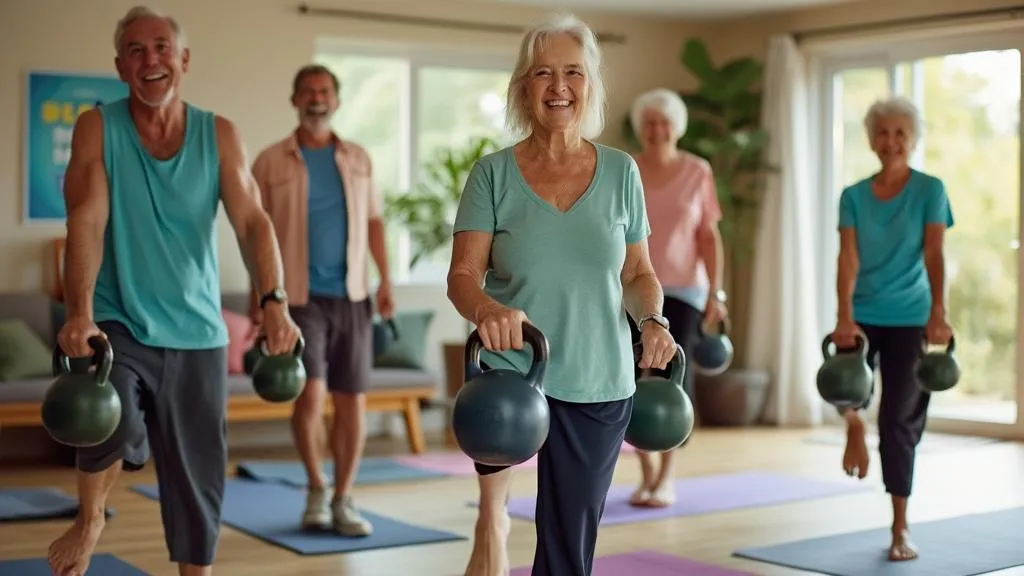Introduction
As the years go by, we start to notice the little things: a missed step, a shaky moment, the fear of falling. But balance isn’t something you have to lose with age—it’s something you can rebuild.
With the right kind of movement, you can strengthen not just your muscles, but your confidence. Kettlebell workouts are ideal for this: they’re simple, powerful, and help your body work as a whole. In just 15 minutes a day, you can take real steps toward feeling stable, strong, and secure in your everyday life.
This article will walk you through a short, effective kettlebell circuit designed especially for seniors—easy to follow, joint-friendly, and focused on helping you feel grounded again.
Benefits of Kettlebell Training for Seniors
Before diving into the workout, let’s explore some advantages of kettlebell training for seniors:
- Improved Balance and Stability: Kettlebell exercises often require coordination and core engagement, which directly contribute to better balance.
- Functional Strength: Kettlebell workouts mimic everyday movements, making them practical for daily life.
- Versatility: Kettlebells can be used for a variety of exercises, targeting different muscle groups while promoting overall fitness.
- Low Impact: Kettlebell training can be easier on the joints compared to some traditional weightlifting methods.
Safety First
Before starting any new exercise program, especially for seniors, it’s essential to consider safety:
- Consult a Doctor: Always consult your healthcare provider before starting a new fitness routine.
- Choose the Right Weight: Start with a lighter kettlebell (5-10 pounds) and increase as you gain strength and confidence.
- Warm-Up: Perform a gentle warm-up to prepare your muscles and joints.
- Listen to Your Body: If you experience pain, stop the exercise and consult a professional.
The 15-Minute Kettlebell Circuit
This circuit includes five exercises that focus on strength, balance, and coordination. Each exercise should be performed for 1 minute, followed by a 30-second rest. Repeat the circuit twice for a complete workout.
1. Kettlebell Deadlift
Focus: Strengthens the legs and back while promoting balance.
How to Perform:
- Stand with feet hip-width apart, kettlebell on the floor between your feet.
- Bend at your hips and knees, keeping your back straight, and grab the kettlebell with both hands.
- Stand up by pushing through your heels and engaging your core.
- Lower the kettlebell back to the ground with control.
Tips:
- Keep the kettlebell close to your body throughout the movement.
- Focus on a neutral spine to prevent injury.
2. Kettlebell Goblet Squat
Focus: Enhances lower body strength and stability.
How to Perform:
- Hold the kettlebell close to your chest with both hands, elbows pointing down.
- Stand with feet shoulder-width apart.
- Lower your body into a squat, keeping your chest lifted.
- Push through your heels to return to the starting position.
Tips:
- Maintain a slow and controlled motion.
- Ensure your knees do not extend past your toes during the squat.
3. Kettlebell Single-Leg Deadlift
Focus: Improves balance and coordination.
How to Perform:
- Stand with feet hip-width apart, holding the kettlebell in one hand.
- Shift your weight to the leg opposite the kettlebell.
- Keeping your back straight, hinge at the hips to lower the kettlebell toward the ground while lifting the opposite leg behind you.
- Return to the starting position and switch sides after 30 seconds.
Tips:
- Focus on a fixed point in front of you to help maintain balance.
- Engage your core throughout the movement.
4. Kettlebell Overhead Press
Focus: Strengthens shoulders and improves stability.
How to Perform:
- Stand with feet shoulder-width apart, holding the kettlebell at shoulder height with one hand.
- Press the kettlebell overhead until your arm is fully extended.
- Lower it back to shoulder height and switch arms after 30 seconds.
Tips:
- Keep your core tight to maintain balance.
- Do not arch your back; keep your movements controlled.
5. Kettlebell Russian Twist
Focus: Engages the core and enhances rotational stability.
How to Perform:
- Sit on the floor with your knees bent, holding the kettlebell with both hands.
- Lean back slightly while keeping your back straight.
- Twist your torso to one side, bringing the kettlebell beside your hip, then twist to the other side.
Tips:
- Keep your feet on the ground if you’re a beginner.
- Focus on slow and controlled movements to engage your core effectively.
Cool Down and Stretch
After completing the circuit, it’s crucial to cool down and stretch to prevent stiffness and improve flexibility. Here are a few gentle stretches:
- Hamstring Stretch: Sit with one leg extended and reach towards your toes.
- Shoulder Stretch: Bring one arm across your body and hold it with the opposite hand.
- Side Stretch: Stand and reach one arm overhead, leaning to the opposite side.
Hold each stretch for 15-30 seconds, breathing deeply to relax your muscles.
Conclusion
Incorporating this 15-minute kettlebell circuit into your weekly routine can significantly improve your balance and strength. Remember to listen to your body, progress at your own pace, and consider working with a fitness professional if possible. Regular exercise, including kettlebell training, can greatly enhance your quality of life as you age. Now, grab your kettlebell, and let’s get started on this journey toward better balance and strength!







